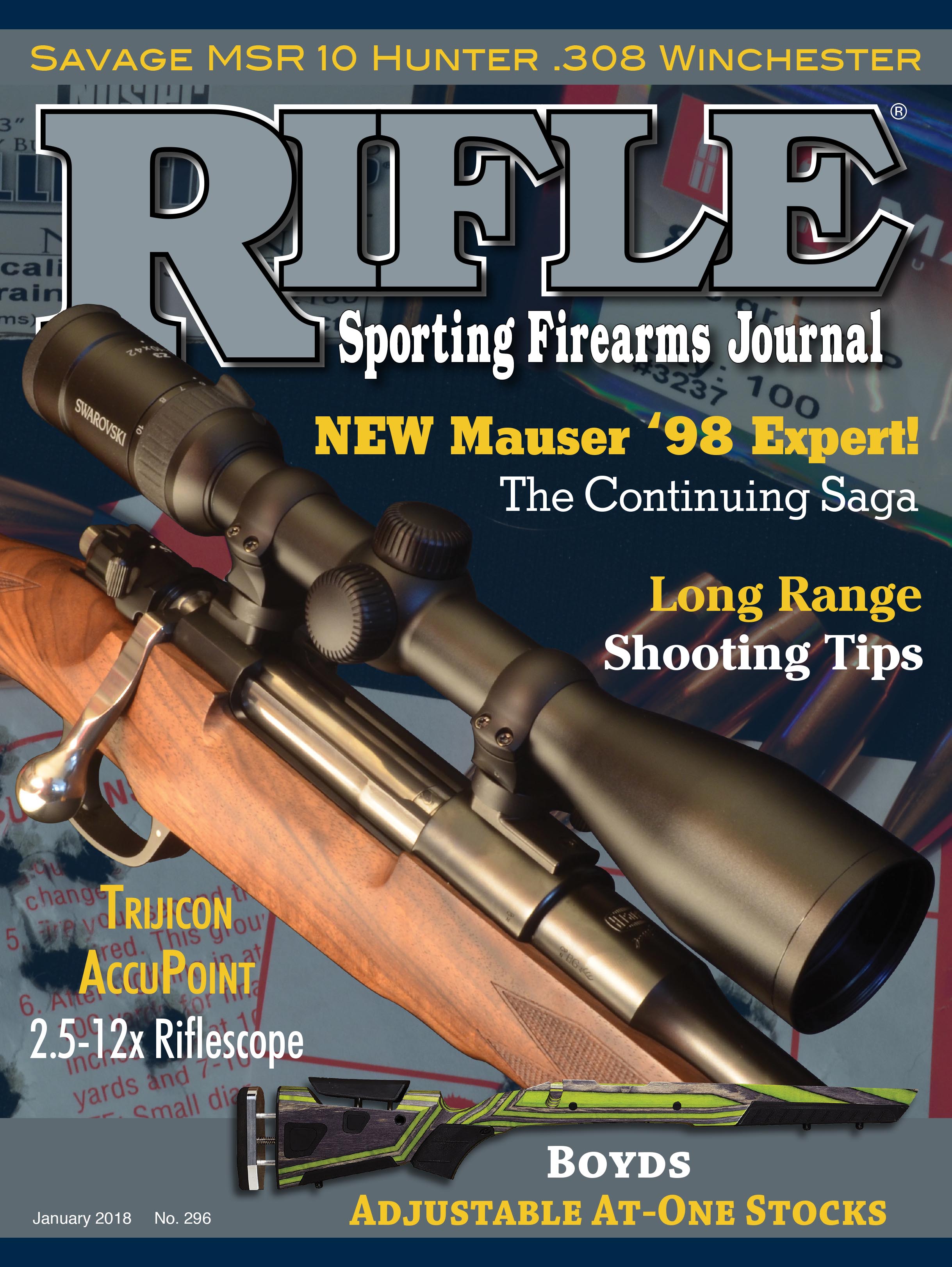Boyds At-One Adjustable Stocks
A Modular Handle for Your Favorite Bolt Rifle
feature By: Stan Trzoniec | January, 18
Having used more than my share of shotguns in casual trap shooting, it’s easy to see that competitive shooters will do anything to get that winning clay busted. The right shotgun is paramount of course, but then competitors like to tinker with making a full or personalized stock for themselves. They will carve the comb down, dish out the stock to fit their face and even add an adjustable recoil pad as to fit them better no matter the weather or the clothes they are wearing.
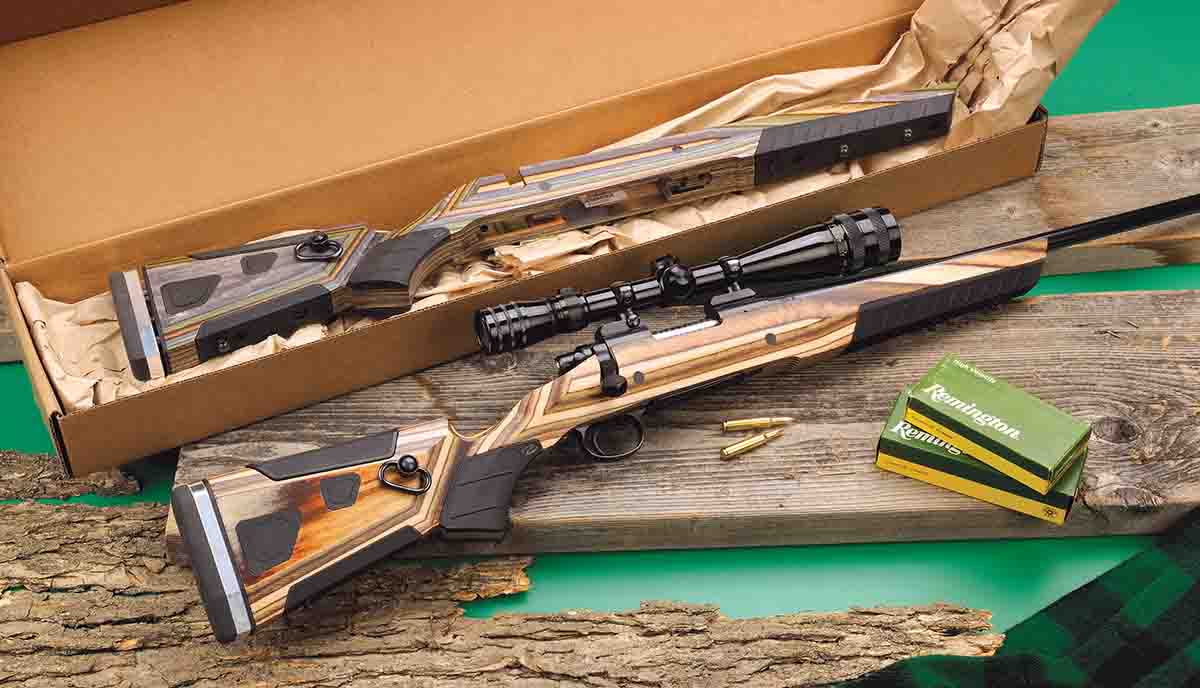
While rifle shooters have been slow in getting into adjustable stocks, things are picking up for sure. Just surfing the web I found a long list of stock makers and rifle manufacturers that indulge in making adjustable stocks for both sporting and AR-15 type rifles. While some are just basic in adjustments, others go full tilt on the changes the shooter can make to the cheekpiece and the comb and buttstock. There is no argument here that since the synthetic stock has come of age, all the modifications necessary to tailor a stock to an individual user can be made right in the mold, saving laborious time with altering and refinishing a wood stock. With the dozens of colors and patterns presently available, it is painless to choose something right off the shelf.
By now, some readers must be asking, “Why do I need an adjustable stock when mine fits me just right?” Indeed. For the most part, hunters go through life (like me) with one stock attached to one action. They are comfortable with it, it shoots in the same place time after time if it is taken care of, and even if you have a synthetic-stocked production rifle right off the shelf, for the most part you are happy.
It’s these four words that seem to bother most people: for the most part. The phrase gets a majority of people rethinking the adjustable stock. Maybe the rifle does not change, but the shooter does over the years. Your facial features may either become larger or smaller, and when you went hunting I’m sure there were times when you wished you had a shorter length of pull simply because of the heavy field jacket you were wearing. With an adjustable stock a rifleman can alter all of the minor corrections with just a push of a button. Such a stock may also be perfect when you want to teach your wife, son or daughter to shoot with the same rifle while making it fit them more comfortably.
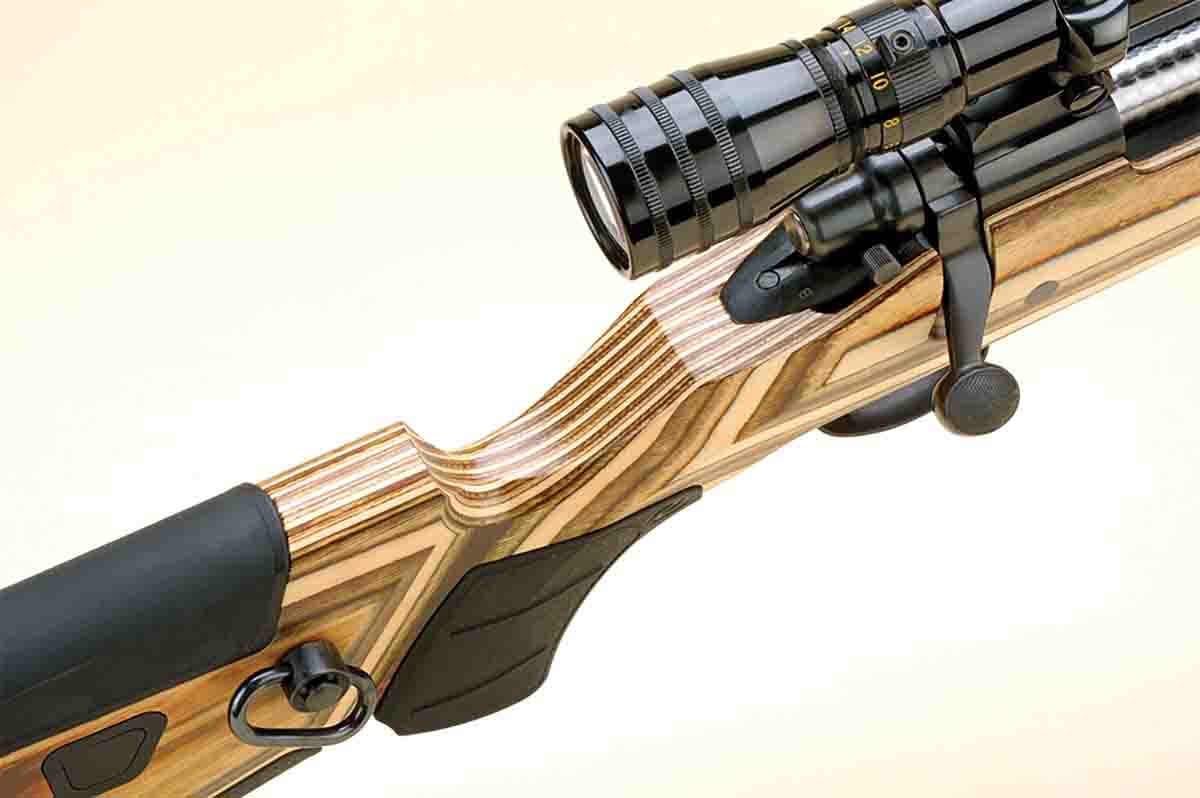
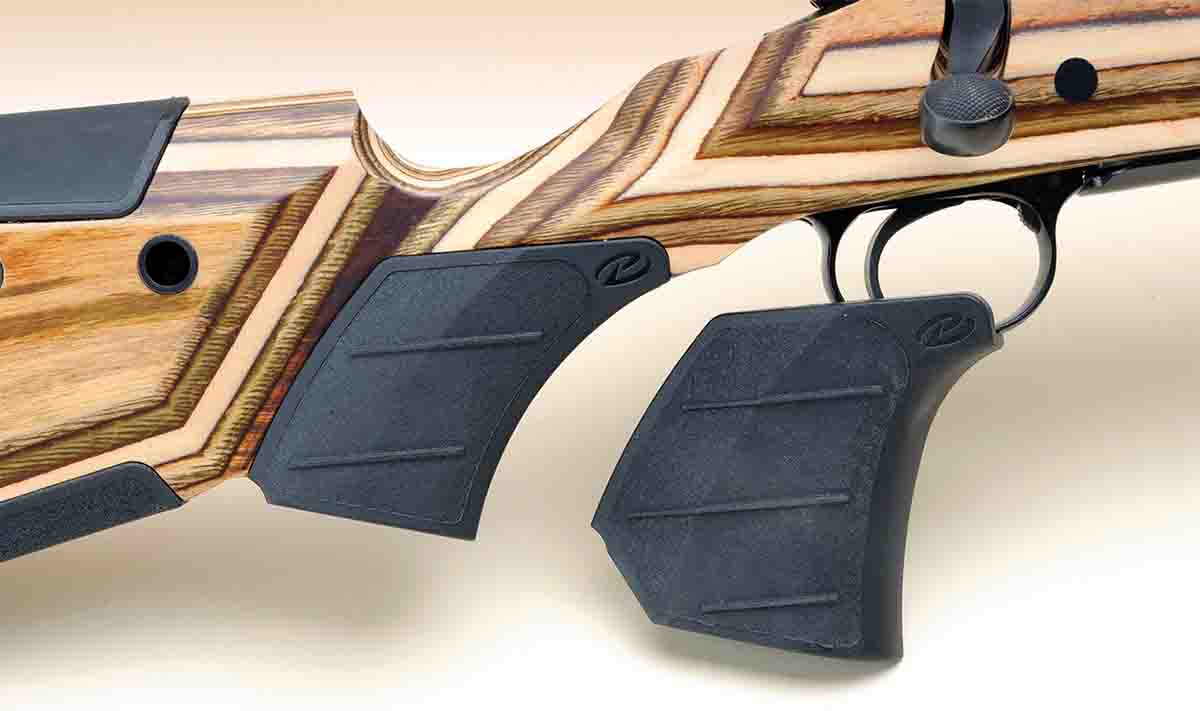
New to the fold is an adjustable stock from Boyds, the At-One stock. From the start, the stock is well thought out with 30 layers of hard maple as the laminate, along with an assortment of colors and inletting to include dozens and dozens of rifle makes, providing a wide selection for any hunter, target shooter or weekend plinker. Looking at the company’s literature, the At-One stock is avilable in 11 different colors, from mild to wild, all with a satin, water-resistant finish.
To try out the At-One, the Coyote laminate was chosen for a Model 700 .222 Remington Magnum, and the Forest Camo version was chosen for a long-action Weatherby Vanguard. Close examination of each stock showed attention to the details that make for a precision fit. Everything was cut cleanly and precisely, there was no sign of dust or sawdust and the inletting was finished with a satin coating (like the exterior) for weather resistance. Both barreled actions dropped right into the stocks with no effort.
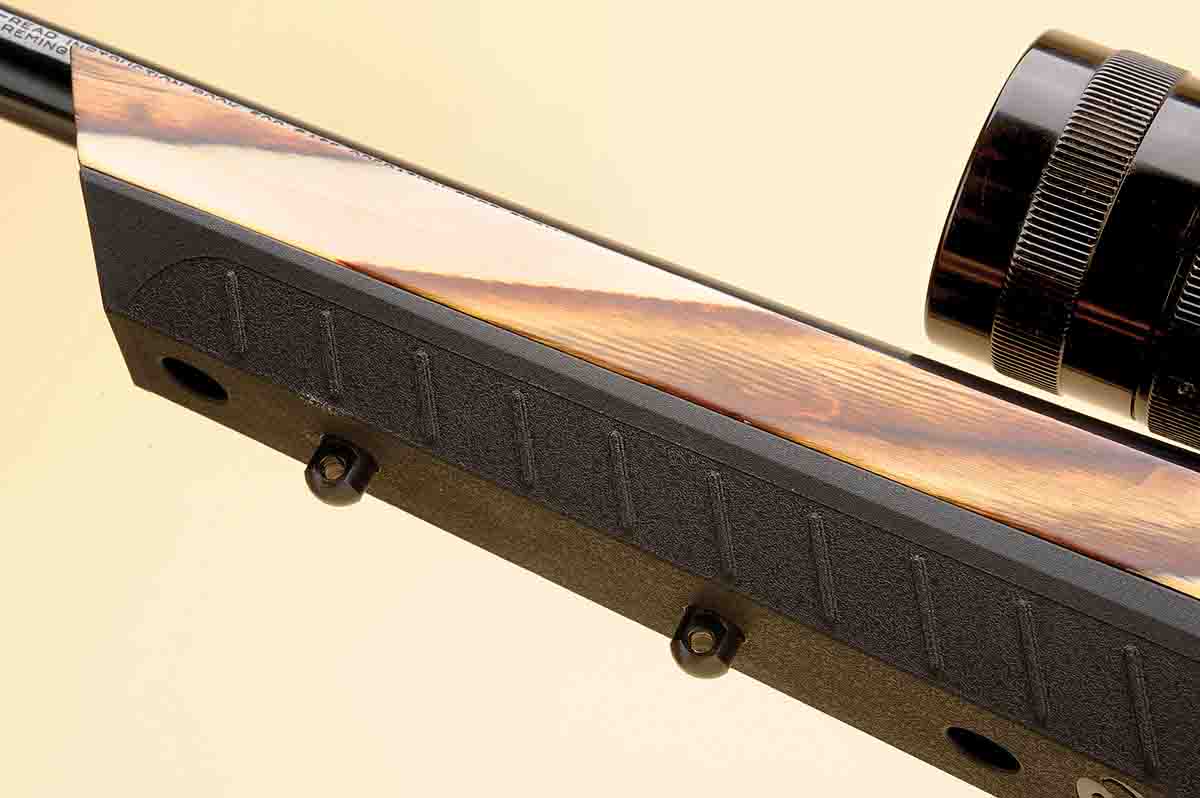
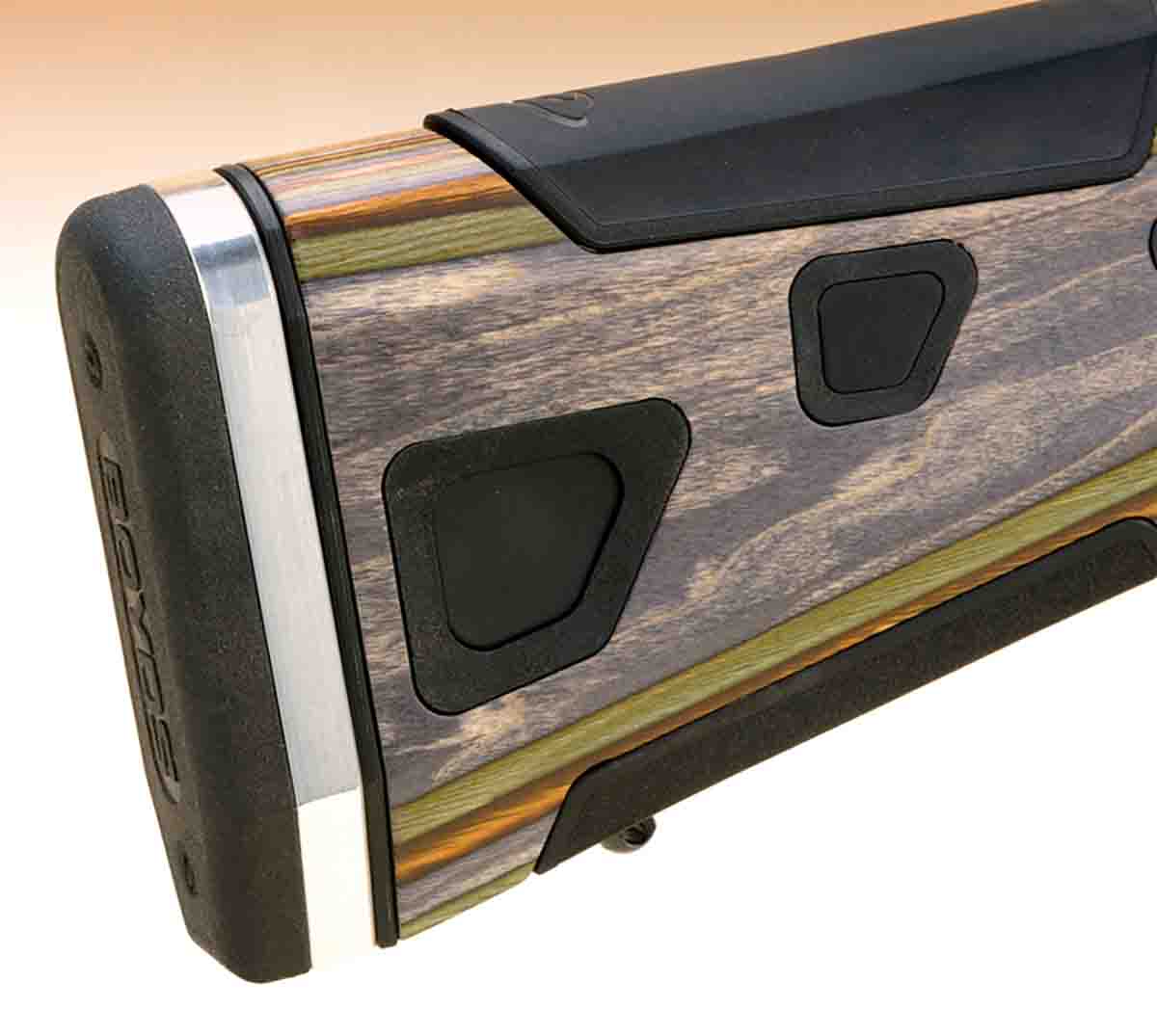
When it comes to the overall design of the At-One stock, in general it follows the classic line of thought, but with some options, which I will get to further on. Looking at the stock for the first time, a more traditionally minded rifle enthusiast might have concern for its sharp lines. Holding the stock (with or without the action), you will note hard angles around the tang, which to some shooters might be a little uncomfortable to grasp for extended periods, as might be the case during extended varmint shooting sessions. If I had some minor criticism of the stock, it would be right at the tang, or wrist, of the stock where the outer edges could be rounded off for a better grip. The same goes for the front area of the comb, as here comfort may be compromised when shooting harder-kicking cartridges.
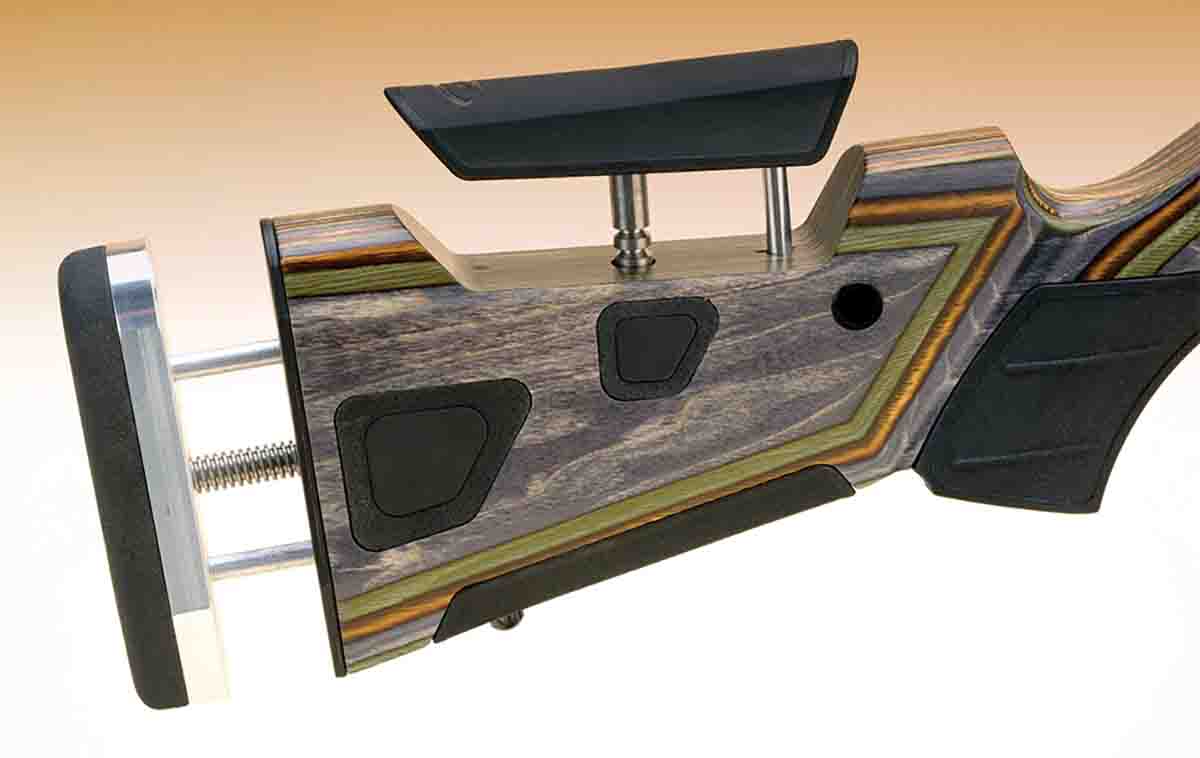
Starting from the muzzle end, there is no forend tip, but this part is cut at a steep, downward angle to prevent the stock from being caught on anything in the woods. Moving back on the forearm and along the rest of the stock, there are over-molded inserts made from high-impact nylon or thermoplastic elastomer. This particular part is removable, is available in a sporter, polymer rail or varmint width and simply attaches or detaches via a 1⁄8-inch hex or Allen wrench. For convenience, there are twin sling swivel studs; one for a bipod and one for a carry sling, with finger grooves on the varmint insert and serrations on the sporter version for good hand purchase in the field.
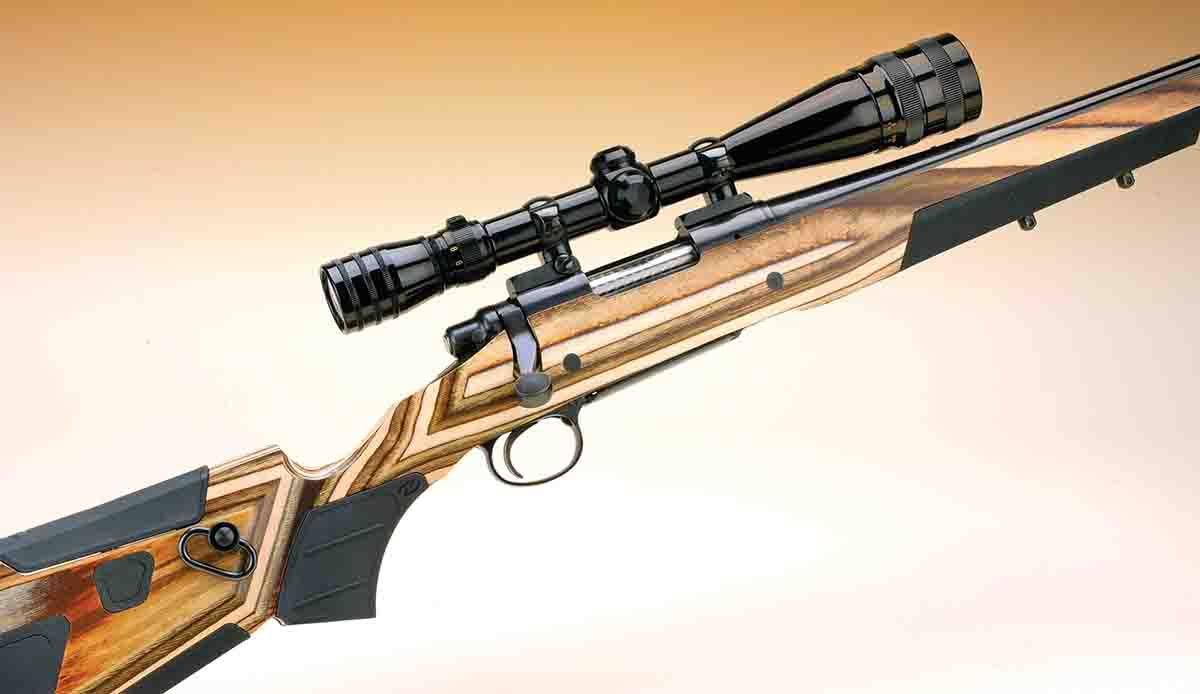
The stock starts to widen toward the rear to accommodate the receiver, magazine and trigger group. To add strength to this section of the stock, dual through-stock screws are included and fit on both ends of the main receiver inletting. At the pistol grip, the sweep is about right for both offhand and prone shooting, and again there is a trio of interchangeable inserts. One is for a traditional-type feel (a little small for my average hands) but affords the opportunity to change grip panels to fit your hand size or hunting style. Next is the target grip, which is a little larger. The varmint inserts are larger, due to the fact that they have less of an outward sweep and extend downward by a good half inch for comfort. Like the forend inserts, the grips are interchangeable with a common 1⁄8-inch hex wrench. Prices on these inserts run from about $15 to $17.
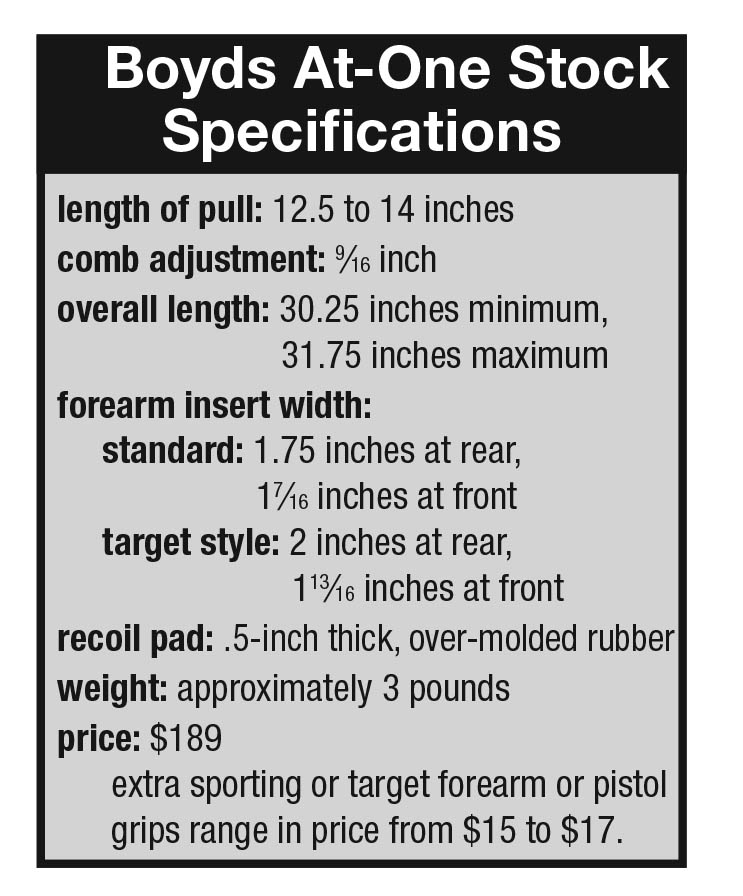
All that aside, this stock really shines from the pistol grip back. First, the comb adjusts up and down with a quick push of a button on the upper part of the stock. This I find to be an interesting feature in that when shooting prone, I always like a lower comb as I don’t have the body flexibility when compared to shooting from a bench or offhand. Comprised of a plastic assembly with a top section of over-molded rubber, adjustments can be as little as 1⁄8 inch up or down for a total of 9⁄16 inch. The movable comb varies in width from about 1.50 inches at the front to 1.46 inches at the rear, making it comfortable for most shooters. There is no cheekpiece, but I never had a hard time in getting used to shooting my rifle when attached to the At-One stock.
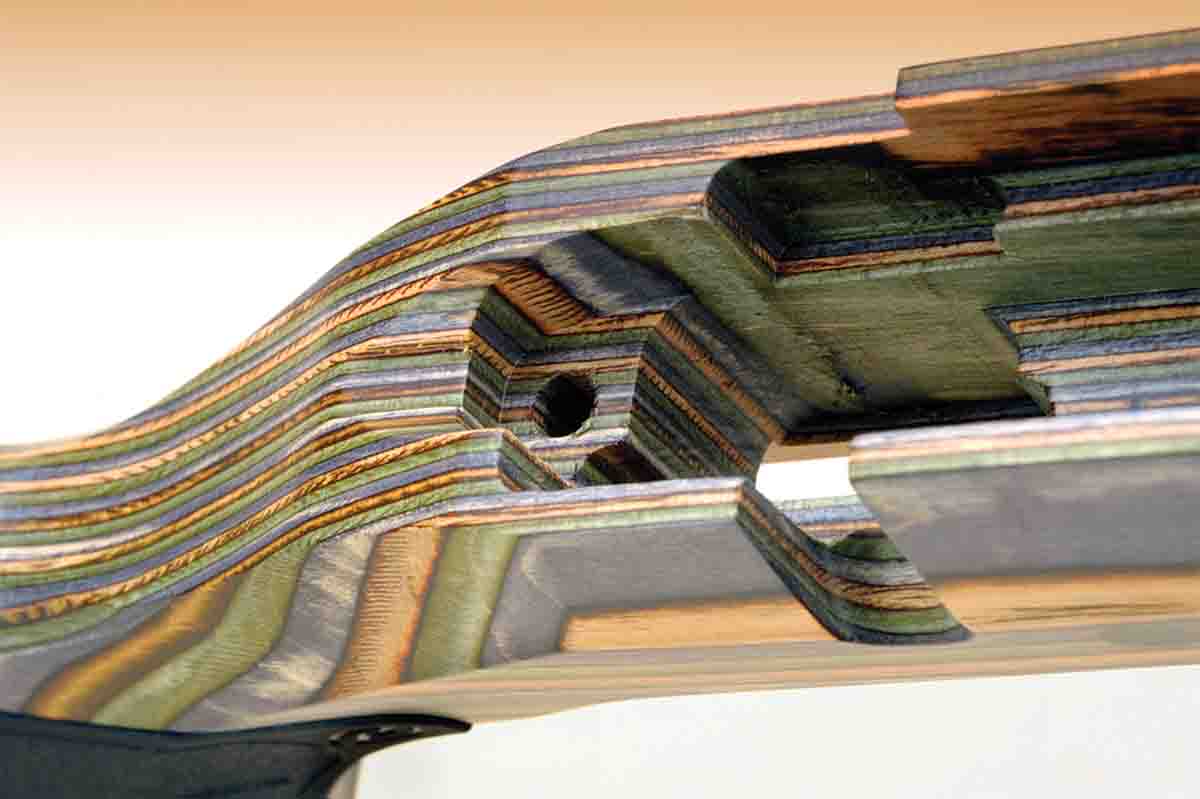
While the adjustable comb is an asset, the recoil pad also offers varying degrees of adjustment. According to Boyds, length of pull can be set for as short as 12.5 to as long as 14 inches. Again, the adjustments are simple: push the black button and pull or push the pad to accommodate your favored shooting position. The recoil pad has an aluminum “spacer” with an over-molded rubber body to absorb recoil. When moving the pad – like the comb adjustment – after you have finalized the setting, push down or in on the comb or pad to confirm and stabilize the setting.
For carry convenience, Boyds has thoughtfully included a quick detach connection (or socket) on either side of the stock. While there are sling swivel studs on the stock, I like this idea as it allows the user to carry the rifle flat on your back when moving around.
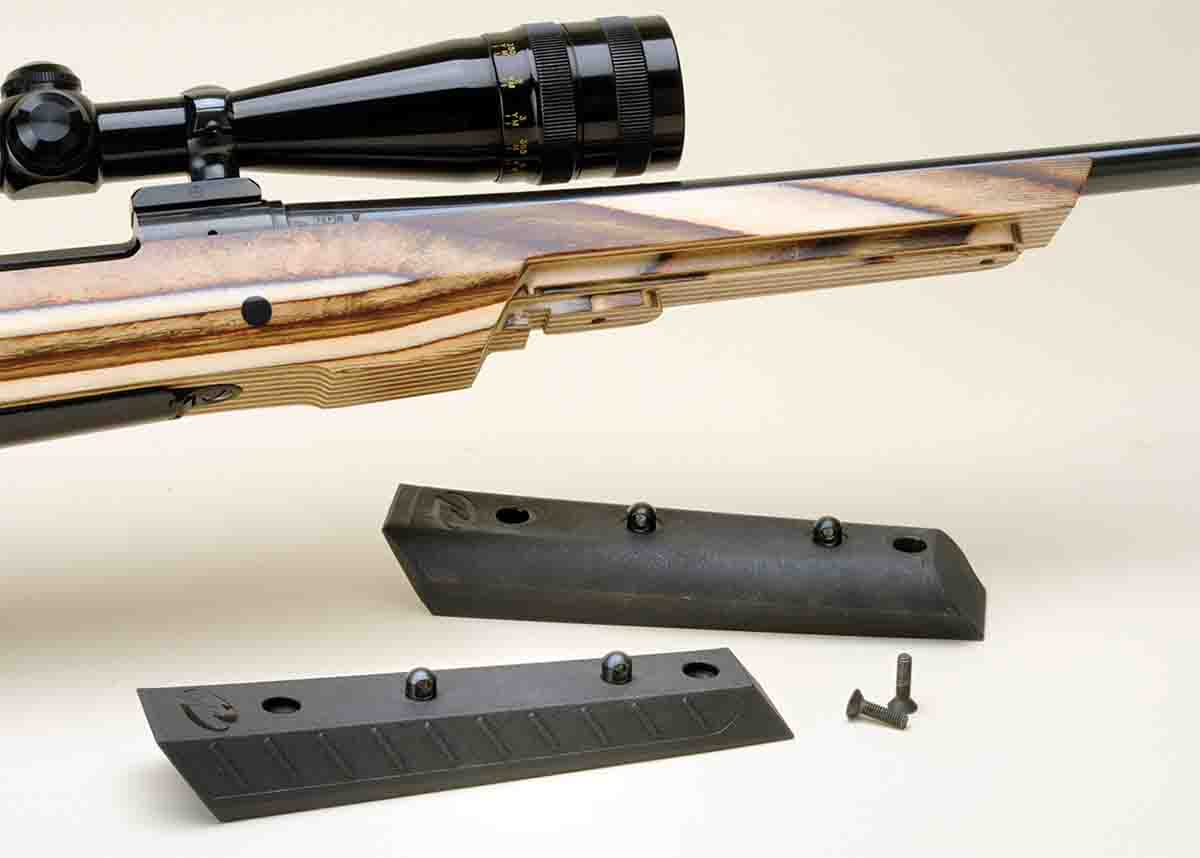
Taking my Remington Model 700 .222 Remington Magnum to the range, I checked the accuracy of the rifle bedded in this stock against the accuracy of the factory wood stock with commercial ammunition. With the factory stock, Remington 55-grain pointed softpoints hit the 100-yard mark at just around an inch for three shots, which according to my records was exactly how it performed the last time I shot it. A few handloads grouped a little more tightly, but for the time being I had none on the shelf. With the Boyds stock the results were the same – no surprise there, as the action did not change – but I did experience a different degree of comfort with the At-One when shooting from the bench. Since the stock was a bit heavier less recoil was noticed, and adjusting the comb did help as I leaned in and down when shooting from the static position.

Overall, I think Boyds has a great product for those shooters who need or want a rifle stock like this. Be aware that it will add a little weight to your present rifle; with the BDL stock, the .222 Remington Magnum action came in at 10.5 pounds; with the At-One stock attached, weight was 11 pounds. This is not enough of an increase to be troubling, and long-range hunters and shooters might welcome it. Although the stock’s sharp lines could use some smoothing out, for anyone who needs some stock adjustment in the field or when shooting from a bench, and can spare the reasonable sum of $189 (starting price), the At-One stock is worth consideration. For more information, contact Boyds Hardwood Gunstocks or log onto www.atonegunstocks.com.


